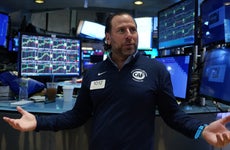The Fed may soon stop raising rates — Is now a good time to buy stocks?

The Bankrate promise
At Bankrate we strive to help you make smarter financial decisions. While we adhere to strict , this post may contain references to products from our partners. Here's an explanation for .
After raising interest rates with unprecedented speed to combat inflation, the Federal Reserve now appears to be done with its full-on assault on rising prices, as indicated by statements at its recent meeting in early May. So the question for many investors now is: Is it time to buy stocks?
Stocks have rushed higher in 2023
For investors, the economy is presenting conflicting data. On one side, employment remains strong and wages are growing. On the other, various economic indicators show weakness, including a huge spread between interest rates for costly short-term money and cheaper long-term money. This so-called yield curve inversion usually precedes a recession.
Yet the stock market has zoomed higher to start 2023, presumably in the optimistic belief that the Fed would soon pull back on increasing interest rates. As of May 11, the S&P 500 has risen about 8 percent, while the Nasdaq Composite has raced even higher, up almost 18 percent.
But with many market watchers expecting a recession and earnings forecasts for companies yet to move significantly lower, are investors being lulled into a bear market trap? That is, are prices melting up just as corporate earnings are set to melt down, roping in the unsuspecting?
The Fed is done raising rates, say experts
Investors expect the Fed is done raising interest rates for this economic cycle, after 10 straight meetings when it announced higher rates, dating back to March 2022. The Fed’s statement from its May 2nd-3rd meeting suggested that it had shifted stances to be less aggressive in raising rates.
In fact, markets are expecting the Fed and chair Jerome Powell will have to shift course on rates as early as this year, reducing rates to combat economic weakness.
“We expect no further rate hikes for now, and most likely rate cuts in the fourth quarter of 2023,” says David Keller, chief market strategist at StockCharts.com. “This is very dependent on economic data points between now and September, as the Fed tracks the impact of their previous rate hikes on economic conditions.”
“We’re likely to see a pause next month, and while Jerome Powell has said he doesn’t see rate cuts in 2023, the Fed fund futures market disagrees, pricing in cuts of between 50 to 75 basis points,” says Jason Mountford, trend analyst at Q.ai, an investment platform.
A rate cut would help bolster an economy that is weakening, offering individuals and businesses cheaper credit and allowing more money to flow through the economy. So investors seem to be suggesting significant weakness ahead as high rates work their way through the economy.
Is now the time to buy stocks?
The run-up in stocks to start 2023 may be perplexing to market watchers, especially given the implications of an inverted yield curve. With short-term rates at much higher levels than long-term rates such as the 10-year Treasury, the bond market is preparing for a recession. And with stocks well above their October 2022 lows, investors riding a bullish trend may be thrown.
Those pointing to robust employment as an optimistic reason to invest are like those saying a brilliant sunset foretells even more sunlight in the near future rather than imminent darkness.
“The labor market, which tends to be the last coinciding economic measure to deteriorate at the start of a recession, has shown mixed signs in the previous couple of months,” says Stash Graham, managing director with Graham Capital Wealth Management.
The slowdown in the labor market should show that the economy is clearly weakening, meaning that stocks are probably not an especially attractive place to invest right now. Graham sees a clear downward inflection point in the broader economy over the next three to four months.
“Ongoing recessionary pressures and inflationary concerns suggest limited upside above current levels for the S&P 500 and Nasdaq,” says Keller. “We don’t feel that the markets have priced in the full impact of rising interest rates, and would expect risk assets to retrace lower as a result.”
Keller sees 3,800 as a key level of support for the S&P 500 – now sitting around 4,130 – and notes that we’re now in the market’s seasonally weakest part of the year, from May to October.
“Allocating new capital broadly into the stock market right now represents poor value,” says Graham. “If you plan on putting money into the stock market, it should be within a sector or company you are familiar with.”
For investors, that means sticking to stocks you know are a good value or are a good value at this point in the cycle, or even turning to assets such as bonds that may fare well as rates fall.
“We would expect further strength in defensive areas of the market including mega-cap technology, gold and consumer staples,” says Keller.
When should investors be ready to invest?
If now is not the time to invest in stocks broadly, what signs or indicators should investors be looking for so that they know it’s time to start loading up on stocks?
Experts pointed to a number of signals, including financial and behavioral indicators that show the market is likely bottoming or has bottomed.
“An end to rate hikes is not enough,” says Graham. “Since the market bottom in 1966, there has been no market bottom without the Fed easing monetary policy. Specifically to the Federal Reserve and their monetary policy decisions, history has shown that the market bottoms out typically after the first rate cut.”
The Fed’s first rate cut signals that still-lower rates are on the way, helping to bolster the real economy and making stocks a more attractive investment prospect.
Another signal of the market’s returning health could be what analysts call its “breadth.” When a broad range of stocks begins to move higher together, it indicates good breadth and that the market’s sentiment has changed. In other words, the market is moving higher because most stocks are rising, not just a few of the most highly weighted stocks such as Apple or Amazon.
“When we see breadth indicators like advance-decline lines turning higher, that could indicate an ‘all clear’ of a risk-on environment,” says Keller. “We are not seeing those signs yet.”
Investors should also carefully watch the bond market for signals on when stocks are bottoming.
“You would like to see a yield curve pattern where the 10-year U.S. Treasury yield falls and then increases off the low, and from here, you have a bull steepening where the short end of the yield curve declines faster than the longer end,” says Graham. “At this point, the market is pricing in a high probability of rate cuts and better growth prospects ahead from a friendlier Federal Reserve.”
Investors should pay particular attention to the behavior of other investors, looking for when markets are running scared. This moment often signals a point of capitulation, when investors have thrown their hands up and are just selling because stocks have become too painful to own.
“If we were at a proper market bottom, I expect it to come after months of fear-driven equity outflows,” says Graham.
While it might seem counterintuitive or even scary to invest while the market is plummeting, investors can’t wait for the economy to improve if they’re looking for the best time to buy stocks.
“The stock market is one of the best leading indicators for the economy, so look for stocks to rebound before the economic data really starts to improve,” says Keller.
As legendary investor Warren Buffett once said, “If you wait for the robins, spring will be over.”
How should investors invest now?
Those looking to time the market – always a dicey prospect – need to carefully watch for fear in the market, especially when it’s accompanied by severe declines in stock prices. Then they’ll need to have cash at the ready and be able to choke down their own (likely) overwhelming fear as the market seems to plunge day after day with no respite.
But if you’re buying stocks with the expectation of short-term gains, you’ll need to steel yourself.
“It’s impossible to know for sure when is a good time to buy stocks until after the moment has already passed,” says Mountford. “‘Buying the dip’ has become a meme, because investors have the potential to get burned even if markets are down significantly.”
Investors looking to build wealth over a longer period of time needn’t be too focused on hitting the bottom of the market, however. Instead, their returns will come from adding to their portfolio regularly over time – including when stocks bottom out but also when they rise again. The stock market could still have significant volatility on the way, especially if a serious recession hits.
“With that as a potential outcome on the horizon, the best way for investors to enter the markets now is to invest regularly every month and dollar-cost average their investments,” says Mountford. “That way, they buy less when prices are high, and buy more as prices fall.”
If you’re investing regularly in your 401(k), for example, and you have nerves of steel to continue doing so during a downturn, then you’re taking advantage of dollar-cost averaging. For many investors, setting your investments on auto-pilot is the best way to take their emotions out of the process and still keep investing at lower and lower prices as the market declines.
Bottom line
While the Federal Reserve is probably done raising rates for this economic cycle, say experts, it doesn’t signal the “all clear” for investors to jump back in the pool. A rough recession could still throw the stock market into a fit, meaning investing could also be rough in the near term. Still, long-term investors can use it as an opportunity to invest more at favorable long-term prices.
Editorial Disclaimer: All investors are advised to conduct their own independent research into investment strategies before making an investment decision. In addition, investors are advised that past investment product performance is no guarantee of future price appreciation.
Related Articles



